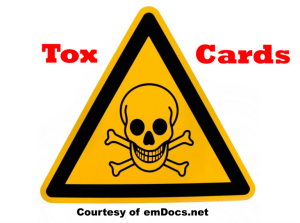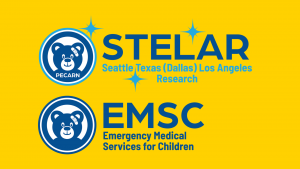Author: Michael Gottlieb, MD, RDMS (Director of Emergency Ultrasound, Department of Emergency Medicine, Rush University Medical Center, Chicago, IL) // Edited by: Alex Koyfman, MD (@EMHighAK) and Brit Long, MD (@long_brit)
Case
A 32-year-old male presents with a headache, neck stiffness, and a sore throat for the past three days. He endorses associated fevers and malaise. He denies any trauma, vision changes, photophobia, phonophobia, or focal neurologic deficits. He denies any sick contacts or recent antibiotics. His vital signs include T: 38.2 ˚C, HR: 106, BP: 112/68, RR: 14, and O2 saturation 99% on room air. He has moderate, tender, cervical lymphadenopathy, and an erythematous throat without exudates. He also has nuchal rigidity, but no focal neurologic deficits.
It is easy to imagine seeing this patient clinically and heading down the lumbar puncture pathway to rule out meningitis. However, it is important to consider the less-common, but equally-dangerous retropharyngeal abscess in patients with these symptoms. This article will provide an up-to-date review of the literature on retropharyngeal abscesses in the adult patient.
Background
Retropharyngeal abscess is an uncommon, but potentially deadly diagnosis in adults. It has been estimated to occur in 4.10 per 100,000 children younger than 20 years in 2012, and the incidence has nearly doubled from the preceding decade.1 However, the incidence in adults is unknown, as the literature is limited to predominately case reports and cases series.
Pathophysiology
A retropharyngeal abscess is a suppurative deep space infection of the neck, occurring in the potential space extending from the base of the skull to the posterior mediastinum and between the posterior pharyngeal wall and prevertebral fascia.2,3 The retropharyngeal space contains a chain of lymph nodes that drains the nasopharynx, adenoids, Eustachian tubes, middle ears, and posterior paranasal sinuses.3 Retropharyngeal abscesses can occur by direct inoculation or lymphangitic spread. In adults, direct inoculation is significantly more common and typically occurs due to blunt or penetrating trauma from an ingested foreign body, laryngoscopy, endoscopy, dental procedure, or other oropharyngeal procedure.2-6 Lymphangitic spread may occur following an infection of the nasopharynx, ears, or throat, but often suggests the presence of an underlying disorder causing immunocompromise (eg, diabetes, human immunodeficiency virus, cancer).2,4,5,7
Presenting Signs and Symptoms
The presentation can be variable in retropharyngeal abscesses, and no specific combination of signs and symptoms is diagnostic.8,9 Patients may complain of fever, neck pain, dysphagia, odynophagia, decreased oral intake, and drooling.2-6,8-10 If the infection spreads inferiorly to the mediastinum, they may develop chest pain and dyspnea, as well.3
Physical examination findings can include cervical lymphadenopathy, decreased neck mobility, torticollis, trismus, stridor, drooling, voice change, and bulging of the posterior pharyngeal wall.3-6,8-10 As the infection progresses, patients will appear increasingly ill and may exhibit different posturing maneuvers to increase airway patency.3
Differential Diagnosis
The differential diagnosis of retropharyngeal abscess includes a range of medical conditions ranging from benign to life-threatening. Below is a table of conditions that may present similarly to retropharyngeal abscess including acute epiglottitis, airway foreign body, cancer, meningitis, mononucleosis, tonsillitis, peritonsillar abscess, cervical spine epidural abscess, osteomyelitis, or diskitis.

Evaluation
While the patient’s history and examination may be suggestive of a retropharyngeal abscess, it is rarely diagnostic in isolation. Labs may be obtained, though they are unlikely to significantly alter the differential diagnosis.
A lateral neck radiograph can be helpful to support the diagnosis (Figure 1). Imaging will demonstrate a widening of the prevertebral soft tissues anterior to the spine.4-6,11 While specific numbers in pediatric patients are well-described for diagnosis, little exists in the adult literature to determine reliable cutoffs. Additionally, one should evaluate for the presence of focal widening or emphysema in the retropharyngeal space, which should raise one’s suspicion for a retropharyngeal abscess.5,11 Unfortunately, lateral neck radiographs have a high false positive rate due to patient positioning, swallowing, and respiration.3 In addition, neck radiographs cannot differentiate between cellulitis and an abscess requiring drainage.3
CT of the neck with intravenous contrast is a more valuable test for identifying a retropharyngeal abscess. Retropharyngeal abscesses will appear as a fluid collection located posterior to the pharynx with surrounding inflammation (Figure 2). CT can be valuable to evaluate for the location and size of the abscess, as well as the degree of airway patency. While CT is often considered the preferred imaging modality, studies have suggested that the accuracy ranges from 78-92% when compared with intra-operative findings, so results should be interpreted with caution.10,12,13
Figure 1. Lateral neck x-ray demonstrating retropharyngeal swelling.
Figure 2. CT of the neck demonstrating retropharyngeal abscess.
Management
As the retropharyngeal abscess progresses, it can lead to airway compromise.2,5,6 Therefore, it is important to evaluate the airway and be prepared to intubate the patient if needed. Intubation should be performed fiberoptically, if possible, due to the retropharyngeal swelling and potential rupture of the abscess.6 A cricothyrotomy kit should also be available.6
Most infections are polymicrobial, and patients will often need broad spectrum antibiotics.2,4,7-9 This may include clindamycin, a third generation cephalosporin (eg, ceftriaxone), or a beta-lactamase resistant penicillin (eg, ampicillin-sulbactam or piperacillin-tazobactam).2,3,9 Some experts also recommend giving concomitant steroids (methylprednisolone 1 mg/kg intravenous) to reduce the inflammation.14 Otolaryngology should be consulted to evaluate for surgical drainage.9 While non-operative management can be considered in select pediatric cases, delayed drainage in adult cases has been associated with worse outcomes and is generally not recommended.15 Patients should be admitted to the general floor or intensive care unit (ICU) depending upon their clinical examination. Any concern for respiratory distress or airway obstruction warrants ICU admission for further monitoring.
Case Conclusion
A CT of the neck with intravenous contrast identified a large retropharyngeal abscess. The patient received intravenous ampicillin-sulbactam and was taken to the operating room for surgical drainage by otolaryngology. He had an unremarkable post-operative course and was discharged two days later.
Key Points
- Fever, neck stiffness, and sore throat should prompt consideration of retropharyngeal abscess
- CT of the neck with intravenous contrast is the imaging study of choice
- Treatment involves broad spectrum antibiotics and otolaryngology consultation
References/Further Reading
- Woods CR, Cash ED, Smith AM, et al. Retropharyngeal and Parapharyngeal Abscesses Among Children and Adolescents in the United States: Epidemiology and Management Trends, 2003-2012. J Pediatric Infect Dis Soc. 2016 Sep;5(3):259-68.
- Brook I. Microbiology and management of peritonsillar, retropharyngeal, and parapharyngeal abscesses. J Oral Maxillofac Surg. 2004 Dec;62(12):1545-50.
- Bochner RE, Gangar M, Belamarich PF. A Clinical Approach to Tonsillitis, Tonsillar Hypertrophy, and Peritonsillar and Retropharyngeal Abscesses. Pediatr Rev. 2017 Feb;38(2):81-92.
- Tannebaum RD. Adult retropharyngeal abscess: a case report and review of the literature. J Emerg Med. 1996 Mar-Apr;14(2):147-58.
- Harkani A, Hassani R, Ziad T, et al. Retropharyngeal abscess in adults: five case reports and review of the literature. Scientific World Journal. 2011;11:1623-9.
- Sharma SB, Hong P. Ingestion and pharyngeal trauma causing secondary retropharyngeal abscess in five adult patients. Case Rep Emerg Med. 2012;2012:943090.
- Brito TP, Hazboun IM, Fernandes FL, et al. Deep neck abscesses: study of 101 cases. Braz J Otorhinolaryngol. 2017 May – Jun;83(3):341-348.
- Craig FW, Schunk JE. Retropharyngeal abscess in children: clinical presentation, utility of imaging, and current management. Pediatrics. 2003 Jun;111(6 Pt 1):1394-8.
- Cirilli AR. Emergency evaluation and management of the sore throat. Emerg Med Clin North Am. 2013 May;31(2):501-15.
- Daya H, Lo S, Papsin BC, et al. Retropharyngeal and parapharyngeal infections in children: the Toronto experience. Int J Pediatr Otorhinolaryngol. 2005 Jan;69(1):81-6.
- Chawla A, Shenoy J, Lim TC, et al. Schematic interpretation of lateral neck radiographs of adults in the emergency department: a pictorial review. Emerg Radiol. 2016 Feb;23(1):79-87.
- Lazor JB, Cunningham MJ, Eavey RD, et al. Comparison of computed tomography and surgical findings in deep neck infections. Otolaryngol Head Neck Surg. 1994 Dec;111(6):746-50.
- Wetmore RF, Mahboubi S, Soyupak SK. Computed tomography in the evaluation of pediatric neck infections. Otolaryngol Head Neck Surg. 1998 Dec;119(6):624-7.
- Pelaz AC, Allende AV, Llorente Pendás JL, et al. Conservative treatment of retropharyngeal and parapharyngeal abscess in children. J Craniofac Surg. 2009 Jul;20(4):1178-81.
- Cramer JD, Purkey MR, Smith SS, et al. The impact of delayed surgical drainage of deep neck abscesses in adult and pediatric populations. Laryngoscope. 2016 Aug;126(8):1753-60.
Figure Captions and Citations
Figure 1. Lateral neck x-ray demonstrating retropharyngeal swelling. Case courtesy of Dr Ian Bickle, <a href=”https://radiopaedia.org/”>Radiopaedia.org</a>. From the case <a href=”https://radiopaedia.org/cases/30018″>rID: 30018</a>
Figure 2. CT of the neck demonstrating retropharyngeal abscess. Case courtesy of Dr Ian Bickle, <a href=”https://radiopaedia.org/”>Radiopaedia.org</a>. From the case <a href=”https://radiopaedia.org/cases/30018″>rID: 30018</a>









1 thought on “More Than a Sore Throat: Evaluation and Management of Retropharyngeal Abscess in the Adult”
Pingback: Peds O- Oxygen, Airway, and Respiratory Disorders – EM Clerkship